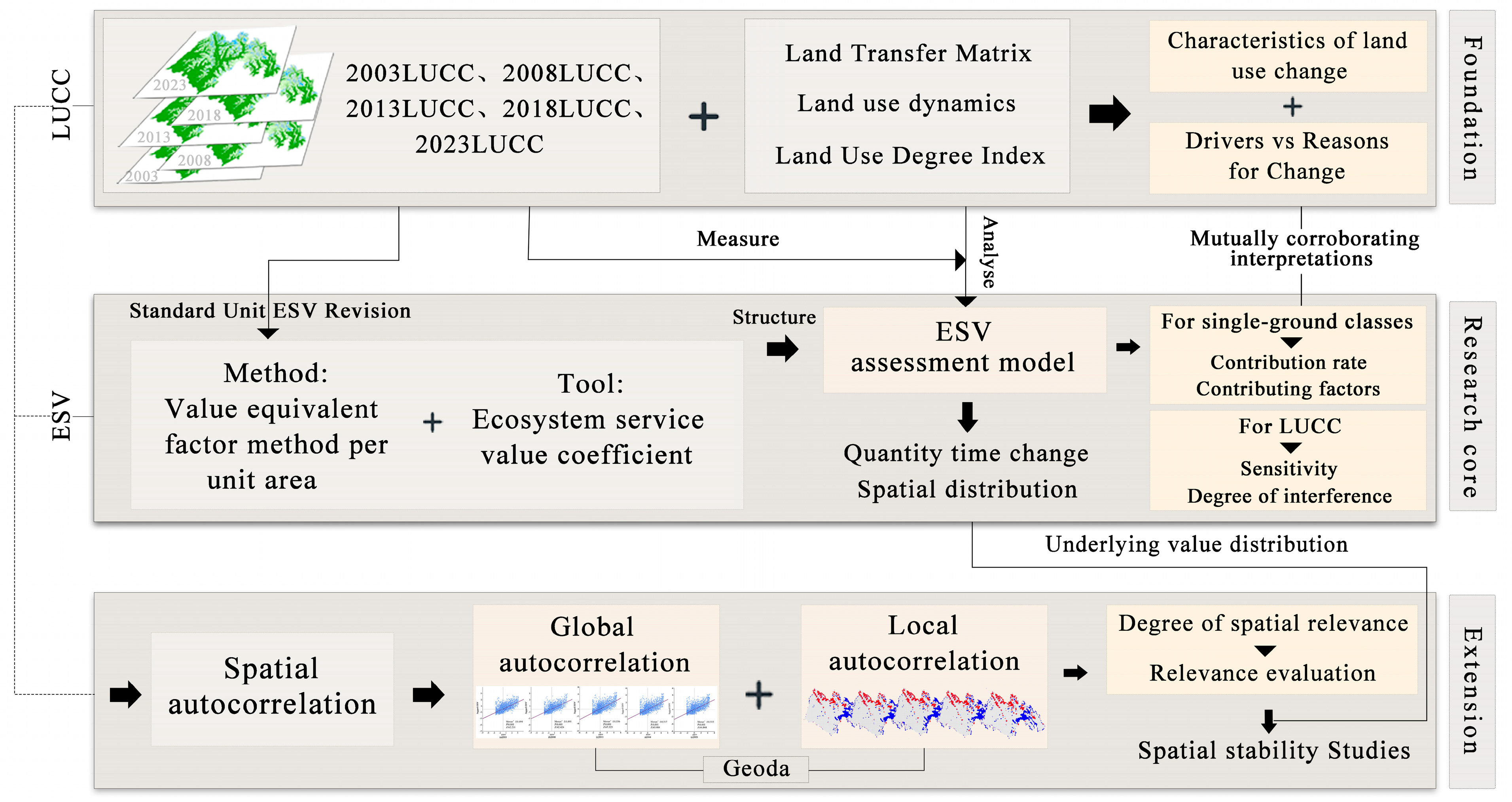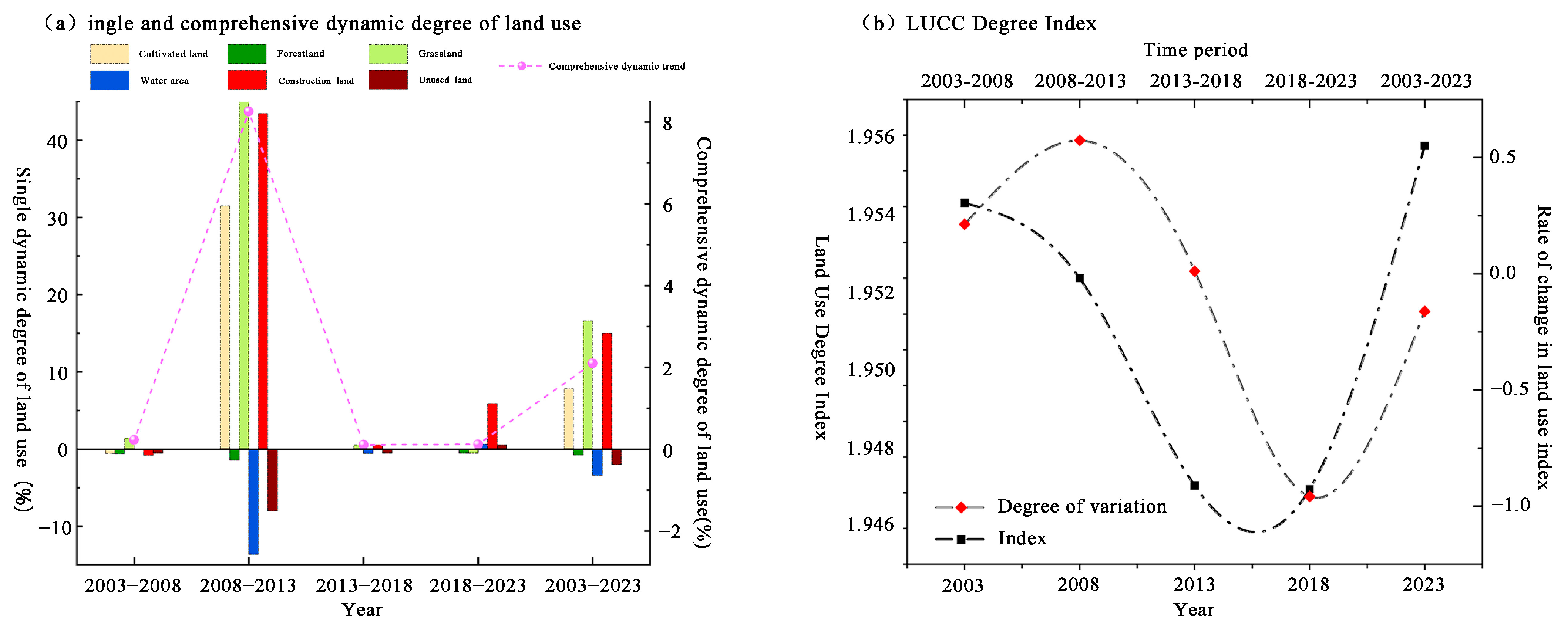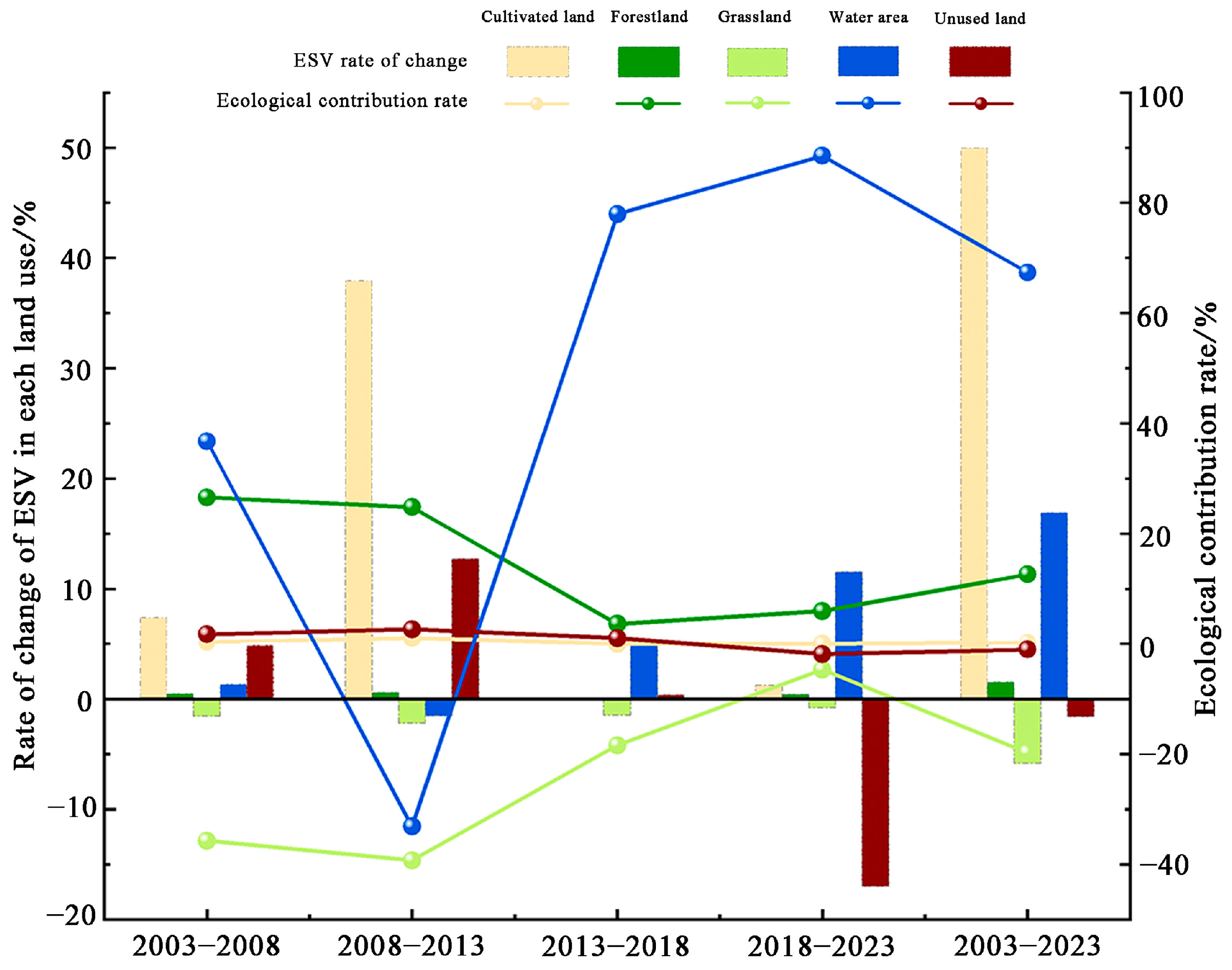Research on the Value of County-Level Ecosystem Services in Highly Mountainous Canyon Areas Based on Land Use Change: Analysis of Spatiotemporal Evolution Characteristics and Spatial Stability
Abstract
1. Introduction
2. Overview of the Study Area
3. Materials and Methods
3.1. Data Sources
3.2. Research Method
3.2.1. Temporal and Spatial Evolution of Land-Use
3.2.2. Ecosystem Service Value (ESV)
3.2.3. Spatial Autocorrelation Analysis
4. Results
4.1. Analysis of Spatial and Temporal Changes in Land-Use Types
4.2. Analysis of Spatiotemporal Changes in the ESV
4.2.1. ESV Time Variation Analysis
4.2.2. ESV Spatial Variation Analysis
4.2.3. Analysis of the Ecological Contribution Rates of Various Land Uses
4.2.4. Ecological Sensitivity Analysis of Various Land Uses
4.3. Spatial Autocorrelation Analysis of ESV
4.3.1. Global Spatial Autocorrelation Analysis of ESV
4.3.2. Local Spatial Autocorrelation Analysis of the ESV
5. Discussion
5.1. The Dynamic Response of ESV to the LUCC
5.2. Stability Analysis of the ESVs
5.3. Policy Impact and Regional Environmental Management
5.4. Research Shortcomings and Prospects
6. Conclusions
- Forestland and grassland are the main land use types in Chayu County. From 2003 to 2023, land use changes, driven by climate change and human activities in the highly mountainous canyon region, were mainly caused by the mutual transformation between grassland and water area; grassland and unused land; and water area and unused land. The period from 2018 to 2023 saw the greatest changes in land use types compared to other periods. The expansion of forestland and water areas during this time is an important indicator of effective ecological and environmental protection efforts in Chayu County in recent years.
- From 2003 to 2023, the overall ESV of Chayu County increased from CNY 169.127 billion in 2003 to CNY 175.686 billion in 2023, with higher values in the northern and western regions and lower values in the central eastern areas. Forestland and water areas were key contributors to the total ESV in Chayu County and essential for maintaining hydrological and climatic regulation. Furthermore, from 2003 to 2023, the sensitivity of Chayu County’s ESV to land use changes revealed a continuous upward trend, with LUCC being a major driver of ESV gains and losses.
- Moran’s I values for Chayu County from 2003 to 2023 across the five periods were 0.494, 0.495, 0.536, 0.517, and 0.515, indicating an overall increasing trend with heightened correlation and enhanced stability. The spatial pattern primarily exhibited high–high and low–low clustering. This is mainly attributable to the unique and complex terrain and landforms of the highly mountainous canyon areas, which have a significant impact on factors such as water bodies, soil types, and vegetation distribution. This results in the regional differentiation of the ecosystem, leading to a marked difference in the spatial distribution of high and low ESVs.
Author Contributions
Funding
Data Availability Statement
Acknowledgments
Conflicts of Interest
Abbreviations
| CNLUCC | China Multi-Period Land Use Remote Sensing Monitoring Dataset |
| ESV | Ecosystem service value |
| LUCC | Land use and land cover change |
| VES | ESV coefficient |
References
- Faber, J.H.; van Wensem, J.V. Elaborations on the use of the ecosystem services concept for application in ecological risk assessment for soils. Sci. Total Environ. 2012, 415, 3–8. [Google Scholar] [CrossRef]
- Gómez-Baggethun, E.; Barton, D.N. Classifying and valuing ecosystem services for urban planning. Ecol. Econ. 2013, 86, 235–245. [Google Scholar] [CrossRef]
- Turner, K.G.; Anderson, S.; Gonzales-Chang, M.; Costanza, R.; Courville, S.; Dalgaard, T.; Dominati, E.; Kubiszewski, I.; Ogilvy, S.; Porfirio, L.; et al. A review of methods, data, and models to assess changes in the value of ecosystem services from land degradation and restoration. Ecol. Model. 2016, 319, 190–207. [Google Scholar] [CrossRef]
- Boone, R.B.; Conant, R.T.; Sircely, J.; Thornton, P.K.; Herrero, M. Climate change impacts on selected global rangeland ecosystem services. Glob. Chang. Biol. 2018, 24, 1382–1393. [Google Scholar] [CrossRef] [PubMed]
- Zhou, T.T.; Jia, W.X.; Liang, Y.; Hong, B.; Wang, K. Urban park’s vertical canopy structure and its varied cooling effect under continuous warming climate. Urban Clim. 2024, 53, 101819. [Google Scholar] [CrossRef]
- Escobedo, F.J.; Kroeger, T.; Wagner, J.E. Urban forests and pollution mitigation: Analyzing ecosystem services and disservices. Environ. Pollut. 2011, 159, 2078–2087. [Google Scholar] [CrossRef]
- Bussmann, R.W. Destruction and management of Mount Kenya’s forests. Ambio 1996, 25, 314–317. [Google Scholar]
- de Araujo Barbosa, C.C.; Atkinson, P.M.; Dearing, J.A. Extravagance in the commons: Resource exploitation and the frontiers of ecosystem service depletion in the Amazon estuary. Sci. Total Environ. 2016, 550, 6–16. [Google Scholar] [CrossRef]
- Dadashpoor, H.; Azizi, P.; Moghadasi, M. Land use change, urbanization, and change in landscape pattern in a metropolitan area. Sci. Total Environ. 2019, 655, 707–719. [Google Scholar] [CrossRef]
- Deng, X.Z.; Gibson, J. Sustainable land use management for improving land ecoefficiency: A case study of Hebei. China Ann. Oper. Res. 2020, 290, 265–277. [Google Scholar] [CrossRef]
- Fu, B.J.; Zhou, G.Y.; Bai, Y.F.; Song, C.C.; Liu, J.Y.; Zhang, H.Y.; Lü, Y.H.; Zheng, H.; Xie, G.D. The mainterrestrial ecosystem services and ecological security in China. Adv. Earth Sci. 2009, 24, 571–576. (In Chinese) [Google Scholar]
- Jing, W.L.; Yu, K.H.; Wu, L.; Luo, P.P. Potential Land Use Conflict Identification Based on Improved Multi-Objective Suitability Evaluation. Remote Sens. 2021, 13, 2416. [Google Scholar] [CrossRef]
- Li, Y.F.; Zhan, J.Y.; Liu, Y.; Zhang, F.; Zhang, M.L. Response of ecosystem services to land use and cover change: A case study in Chengdu City. Resour. Conserv. Recycl. 2018, 132, 291–300. [Google Scholar] [CrossRef]
- Talukdar, S.; Singha, P.; Mahato, S.; Praveen, B.; Rahman, A. Dynamics of ecosystem services (ESs) in response to land use land cover (LU/LC) changes in the lower Gangetic plain of India. Ecol. Indic. 2020, 112, 106121. [Google Scholar] [CrossRef]
- Turner, B.L.; Lambin, E.F.; Reenberg, A. The emergence of land change science for global environmental change and sustainability. Proc. Natl. Acad. Sci. USA 2007, 104, 20666–20671. [Google Scholar] [CrossRef]
- Wang, M.; Sun, X. Potential impact of land use change on ecosystem services in China. Environ. Monit. Assess. 2016, 188, 248. [Google Scholar] [CrossRef]
- Tolessa, T.; Senbeta, F.; Kidane, M. The impact of land use/land cover change on ecosystem services in the central highlands of Ethiopia. Ecosyst. Serv. 2017, 23, 47–54. [Google Scholar] [CrossRef]
- Lu, X.; Shi, Y.Y.; Chen, C.L.; Yu, M. Monitoring cropland transition and its impact on ecosystem services value in developed regions of China: A case study of Jiangsu Province. Land Use Policy 2017, 69, 25–40. [Google Scholar] [CrossRef]
- Hu, X.S.; Hong, W.; Qiu, R.Z.; Hong, T.; Chen, C.; Wu, C. Geographic variations of ecosystem service intensity in Fuzhou City, China. Sci. Total Environ. 2015, 512–513, 215–226. [Google Scholar] [CrossRef]
- Song, W.; Deng, X.Z. Land-use/land-cover change and eco-system service provision in China. Sci. Total Environ. 2017, 576, 705–719. [Google Scholar] [CrossRef]
- Kindu, M.; Schneider, T.; Teketay, D.; Knoke, T. Changes of ecosystem service values in response to land use/land cover dynamics in Munessa–Shashemene landscape of the Ethiopian Highlands. Sci. Total Environ. 2016, 547, 137–147. [Google Scholar] [CrossRef]
- Wilson, C.L.; Matthews, W.H. Mans Impact on the Global Environment: Assessment and Recommendations for Action. In Report of the Study of Critical Environment Problems (SCEP); MIT Press: Cambridge, MA, USA, 1970; p. 319. [Google Scholar]
- Daily, G.C.; Söderqvist, T.; Aniyar, S.; Arrow, K.; Dasgupta, P.; Ehrlich, P.R.; Folke, C.; Jansson, A.; Jansson, B.O.; Kautsky, N.; et al. The value of nature and the nature of value. Science 2000, 289, 395–396. [Google Scholar] [CrossRef]
- Obst, C.; Edens, B.; Hein, L. Ecosystem services: Accounting standards. Science 2013, 342, 420. [Google Scholar] [CrossRef]
- Xie, G.D.; Zhang, C.X.; Zhang, C.S.; Xiao, Y.; Lu, C.X. The value of ecosystem services in China. Resour. Sci. 2015, 37, 1740–1746. [Google Scholar]
- Li, G.; Fang, C.; Wang, S. Exploring spatiotemporal changes in ecosystem service values and hotspots in China. Sci. Total Environ. 2016, 545–546, 609–620. [Google Scholar] [CrossRef]
- Ouyang, X.; He, Q.Y.; Zhu, X. Simulation of impacts of urban agglomeration land use change on ecosystem services value under Multi-Scenarios: Case study in Changsha-Zhuzhou-Xiangtan Urban Agglomeration. Econ. Geogr. 2020, 40, 93–102. [Google Scholar]
- Fei, L.; Shuwen, Z.; Jiuchun, Y.; Liping, C.; Haijuan, Y.; Kun, B. Effects of land use change on ecosystem services value in West Jilin since the reform and opening of China. Ecosyst. Serv. 2018, 31, 12–20. [Google Scholar] [CrossRef]
- Zhang, J.; Liu, Z.L.; Shi, Y.; Zou, Z.Y. Spatial response of ecosystem service value to urbanization in fragile vegetation areas based on terrain gradient. Int. J. Environ. Res. Public Health 2022, 19, 15286. [Google Scholar] [CrossRef]
- Yang, J.; Xie, B.P.; Zhang, D.G. Spatial-temporal evolution of ESV and its response to land use change in the Yellow River Basin. China Sci. Rep. 2022, 12, 13103. [Google Scholar] [CrossRef]
- Cui, X.F.; Liu, C.C.; Shan, L.; Lin, J.Q.; Zhang, J.; Jiang, Y.H.; Zhang, G.H. Spatialtemporal responses of ecosystem services to land use transformation driven by rapid urbanization: A case study of Hubei Province, China. Int. J. Environ. Res. Public Health 2021, 19, 178. [Google Scholar] [CrossRef]
- Chen, G.J. Some theoretical and strategic considerations on the construction of ecological barrier in the upper reaches of Yangtze River. Decis.-Mak. Consult. 2016, 3, 8–9+12. [Google Scholar]
- Liu, W.R.; Chen, C.B.; Luo, G.P.; He, H.L. Change processes and trends of land use/cover in the Balkhash Lake basin. Arid. Zone Res. 2021, 38, 1452–1463. [Google Scholar] [CrossRef]
- Li, C.A.; Liu, L.; Qu, B.; Nie, C.M.; Ning, L.L.; Li, Y.L.; Wang, H.; Liu, X.Y.; Yang, S.H. Temporal and spatial changes of land use/cover and its driving factors in Anhui Province. J. Nanjing For. Univ. 2023, 47, 213–223. [Google Scholar] [CrossRef]
- Ma, S.Z.; Shi, M.C.; Yang, G.S.; Xu, X.T.; Yin, J. Spatial and temporal dynamic change analysis of land use based on GIS: A case study of reclamation area in Tarim Basin. Res. Soil Water Conserv. 2013, 20, 177–181. [Google Scholar]
- Zhu, L.N.; Zhao, M.D.; Li, Y.F.; Fan, Y.; Wang, J. The Space-time Relationship beteen the Ecosystem Service Value and the Human Activity Intensity in Xi’an Metropolitan Area. J. Ecol. Rural Environ. 2024, 40, 325–334. [Google Scholar] [CrossRef]
- Ma, W.B.; Yang, F.; Wang, N.; Zhao, L.J.; Tan, K.; Zhang, X.F.; Zhang, L.J.; Li, H.D. Study on the spatial-temporal evolution and driving factors of ecosystem service value in the Yangtze River Delta urban agglomeration. J. Ecol. Rural Environ. 2022, 38, 1365–1376. [Google Scholar] [CrossRef]
- Chen, W.X.; Li, J.F.; Zhu, L.J. Spatial differentiation of ecosystem service value in the middle reaches of Yangtze River and sensitivity analysis. J. Nat. Resour. 2019, 34, 325–337. [Google Scholar] [CrossRef]
- Jia, Z.H.; Gu, G.F. Temporal and spatial evolution of population distribution in Northeast China and its influencing factors. Econ. Geogr. 2016, 36, 60–68. [Google Scholar] [CrossRef]
- Ka, S.M.; Yang, S.T.; Si, M.Y. Effects of land use change on ecosystem service value in Ebi Lake Basin, Xinjiang. Trans. Chin. Soc. Agric. Eng. 2019, 35, 260–269. [Google Scholar] [CrossRef]
- Du, M.Y.; Shu, M.Y.; Cai, J.G. Temporal and spatial changes of land use and landscape pattern in Qingshan Lake region, Lin’an District. Shaanxi For. Sci. Technol. 2021, 49, 28–34. [Google Scholar] [CrossRef]
- Yu, K.J. Climate Design for One Planet. Landsc. Archit. Front. 2024, 12, 4–7. [Google Scholar] [CrossRef]
- Gao, Y.J.; Zhao, J.Y.; Yu, K.H. Effects of block morphology on the surface thermal environment and the corresponding planning strategy using the geographically weighted regression model. Build. Environ. 2022, 216, 109037. [Google Scholar] [CrossRef]
- Han, Z.; Song, W.; Deng, X.Z. Responses of ecosystem service to land use change in Qinghai Province. Energies 2016, 9, 303. [Google Scholar] [CrossRef]
- Zhang, Q.W.; Yang, Y.; Yuan, Y.; Han, J.Y.; Li, D.H. Research on the Territorial Ecological Restoration of Counties for the Increase of Carbon Sinks—A Case Study of Wensu County, Xinjiang Uygur Autonomous Region, China. Landsc. Archit. Front. 2024, 12, 10–26. [Google Scholar] [CrossRef]
- Zhou, D.Y.; Wang, J.; Zhou, F.J. Evaluation of land use change and ecosystem service value based on multi-scenario analysis of PLUS model. J. Gansu Agric. Univ. 2023, 58, 198–209. [Google Scholar] [CrossRef]
- Long, H.; Liu, Y.; Hou, X.; Li, T.; Li, Y. Effects of land use transitions due to rapid urbanization on ecosystem services: Implications for urban planning in the new developing area of China. Habitat Int. 2014, 44, 536–544. [Google Scholar] [CrossRef]
- Wang, Z.; Wang, H.Y.; Qin, F.; Han, Z.; Miao, C. Mapping an urban boundary based on Multi-Temporal Sentinel-2 and POI Data: A case study of Zhengzhou City. Remote Sens. 2020, 12, 4103. [Google Scholar] [CrossRef]
- Du, X.; Huang, Z. Ecological and environmental effects of land use change in rapid urbanization: The case of Hangzhou, China. Ecol. Indic. 2017, 81, 243–251. [Google Scholar] [CrossRef]
- Lian, X. Review on advanced practice of provincial spatial planning: Case of a western, less developed province. Int. Rev. Spat. Plan. Sustain. Dev. 2018, 6, 185–202. [Google Scholar] [CrossRef]
- Vialatte, A.; Barnaud, C.; Blanco, J.; Ouin, A.; Choisis, J.-P.; Andrieu, E.; Sheeren, D.; Ladet, S.; Deconchat, M.; Cĺement, F.; et al. A conceptual framework for the governance of multiple ecosystem services in agricultural landscapes. Landsc. Ecol. 2019, 34, 1653–1673. [Google Scholar] [CrossRef]
- Yu, K.H.; Zhang, Y.; Li, D.N.; Montenegro-Marin, C.E.; Kumar, P.M. Environmental planning based on reduce, reuse, recycle and recover using artificial intelligence. Environ. Impact Assess. Rev. 2021, 86, 106492. [Google Scholar] [CrossRef]
- Xiao, Y.; Huang, M.; Xie, G.; Zhen, L. Evaluating the impacts of land use change on ecosystem service values under multiple scenarios in the Hunshandake region of China. Sci. Total Environ. 2022, 850, 158067. [Google Scholar] [CrossRef] [PubMed]









| Type | Unutilized Prefecture Level | Forest, Grass, and Water Use Land Level | Agricultural Land Level | Construction Land Settlement Level |
|---|---|---|---|---|
| Land use type | Unused land | Forestland, grassland, water area | Cultivated land | Construction land and residential areas |
| Graded index | 1 | 2 | 3 | 4 |
| Type of Ecosystem Service | Equivalent Value of Ecosystem Services per Unit Area | ||||||
|---|---|---|---|---|---|---|---|
| Primary Classification | Secondary Classification | Cultivated Land | Forest Land | Grass Land | Water Area | Construction Land | Unused Land |
| Provisioning services | Food production | 2796.79 | 639.09 | 590.49 | 1105.05 | 0.00 | 12.66 |
| Material production | 620.10 | 1468.00 | 868.90 | 615.80 | 0.00 | 37.97 | |
| Water resources supply | −3302.99 | 759.31 | 480.90 | 10,984.67 | 0.00 | 25.31 | |
| Regulating services | Gas regulation | 2252.62 | 4827.94 | 3053.94 | 2404.48 | 0.00 | 164.52 |
| Climate regulation | 1176.93 | 14,445.85 | 8073.99 | 5424.00 | 0.00 | 126.55 | |
| Purify the environment | 341.69 | 5644.20 | 2665.17 | 7853.79 | 0.00 | 518.86 | |
| Hydro logical regulation | 3783.89 | 9453.40 | 5914.00 | 112,715.12 | 0.00 | 303.72 | |
| Supporting services | Soil conservation | 1316.14 | 5878.32 | 3720.61 | 2733.51 | 0.00 | 189.83 |
| Maintain nutrient cycling | 392.31 | 449.26 | 286.77 | 210.83 | 0.00 | 12.66 | |
| Biodiversity | 430.28 | 5353.13 | 3383.23 | 8799.63 | 0.00 | 177.17 | |
| Cultural services | Aesthetic landscape | 189.83 | 9390.12 | 1493.31 | 5661.15 | 0.00 | 75.93 |
| total | 9997.57 | 58,308.60 | 30,531.31 | 158,508.03 | 0.00 | 1645.17 | |
Disclaimer/Publisher’s Note: The statements, opinions and data contained in all publications are solely those of the individual author(s) and contributor(s) and not of MDPI and/or the editor(s). MDPI and/or the editor(s) disclaim responsibility for any injury to people or property resulting from any ideas, methods, instructions or products referred to in the content. |
© 2025 by the authors. Licensee MDPI, Basel, Switzerland. This article is an open access article distributed under the terms and conditions of the Creative Commons Attribution (CC BY) license (https://creativecommons.org/licenses/by/4.0/).
Share and Cite
Zhang, L.; Yu, K.; Zhang, Y.; Wei, J.; Yang, W.; Wang, X. Research on the Value of County-Level Ecosystem Services in Highly Mountainous Canyon Areas Based on Land Use Change: Analysis of Spatiotemporal Evolution Characteristics and Spatial Stability. Land 2025, 14, 398. https://doi.org/10.3390/land14020398
Zhang L, Yu K, Zhang Y, Wei J, Yang W, Wang X. Research on the Value of County-Level Ecosystem Services in Highly Mountainous Canyon Areas Based on Land Use Change: Analysis of Spatiotemporal Evolution Characteristics and Spatial Stability. Land. 2025; 14(2):398. https://doi.org/10.3390/land14020398
Chicago/Turabian StyleZhang, Linrui, Kanhua Yu, Yue Zhang, Jiabin Wei, Wenting Yang, and Xuhui Wang. 2025. "Research on the Value of County-Level Ecosystem Services in Highly Mountainous Canyon Areas Based on Land Use Change: Analysis of Spatiotemporal Evolution Characteristics and Spatial Stability" Land 14, no. 2: 398. https://doi.org/10.3390/land14020398
APA StyleZhang, L., Yu, K., Zhang, Y., Wei, J., Yang, W., & Wang, X. (2025). Research on the Value of County-Level Ecosystem Services in Highly Mountainous Canyon Areas Based on Land Use Change: Analysis of Spatiotemporal Evolution Characteristics and Spatial Stability. Land, 14(2), 398. https://doi.org/10.3390/land14020398





